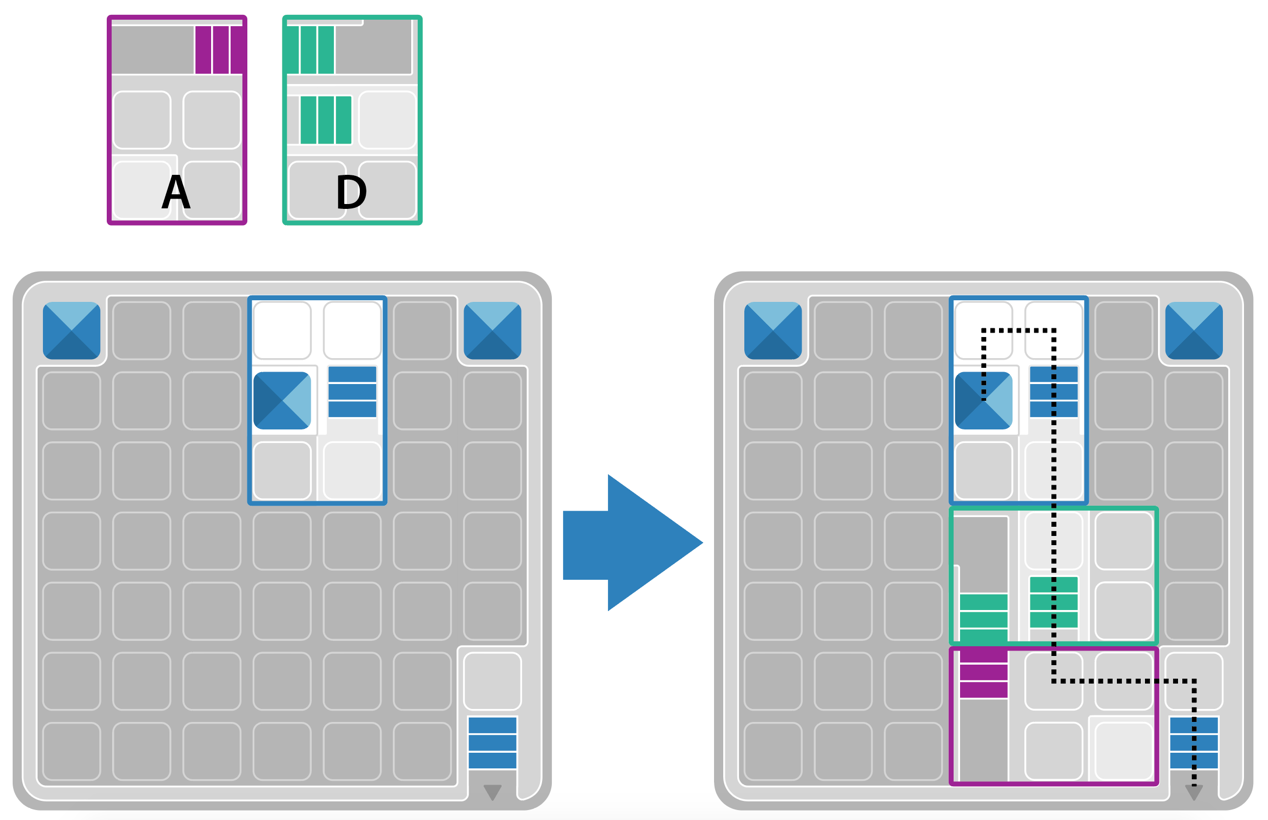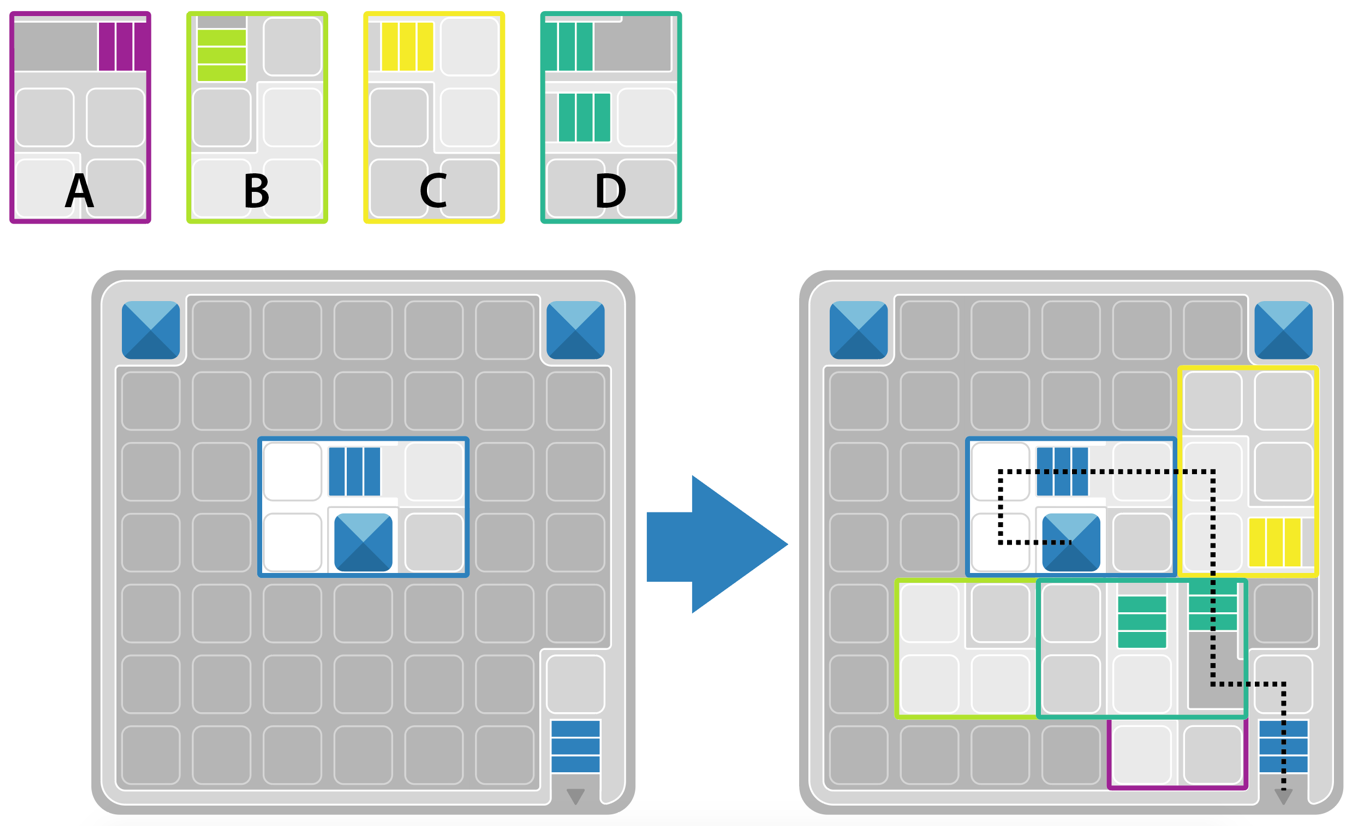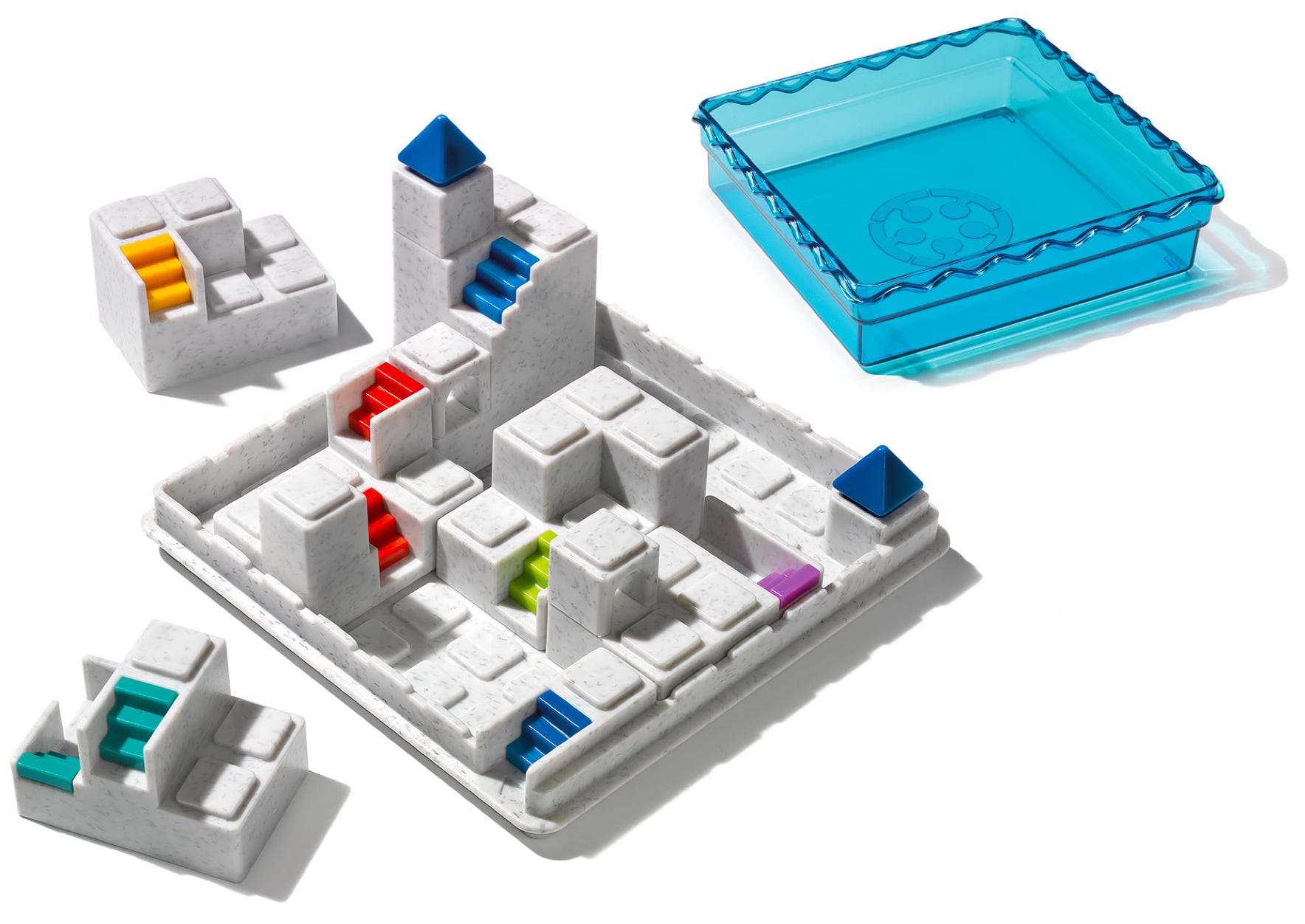
Atlantis Escape
The story behind the creation of Atlantis Escape (for SmartGames)
Raf Peeters, January 2019
2018 was a good year in terms of completing things on my wish list. One of my oldest designs (and still one of my favorites) is Camelot JR. When I was working on that game more than 10 ago, I already wanted to make a more adult version. Although Camelot JR is of course made of 3D wooden blocks, the concept is basically a 2D puzzle game. And for adults I wanted to make a real 3D game.
A STAIRWAY TO HEAVEN (OR TO HELL)?
This is a concept that changed completely during the development. It started as a simple path connection game with 4 L-shaped puzzle pieces that were double sided. The paths included stairways, although they didn’t have a real function. They were only added to make it visually interesting (you know I am fascinated in mazes, stairways and bridges). At one point we made a 3D printed prototype and started playing with it. The prototype worked, but I discovered that I could also stack the pieces on top of each other, to create more complex paths. This was much more interesting than the original idea. Maybe I designed already too many puzzle games with double sided pieces and this was something I never tried before.
At the same time this new idea was also much more challenging. This was one of the few times I thought that the chances of success would be very small. But in the end it did work out. First we made the puzzle pieces simpler, by reducing them to 2x3 rectangles. This made them easier to place next and on top of each other. Then I started working on the position of the stairways on the puzzle pieces. Each piece needed to have the right balance between options and constraints. Higher parts make connections on the highest floor, but block the path on levels below. And higher parts also limit the number of ways to stack the pieces.
We tried many versions, but we always got stuck on the same problem. Some combinations of puzzle pieces resulted in enough interesting challenges, but the solutions to these challenges were seldom unique. So in the end we changed the concept again, by indicating which puzzle pieces you are allowed to use (similar to Camelot JR). This way we could use 5 different puzzle pieces (for enough variation) but at the same time limit the number of solutions for every challenge to one.
A WAY OUT
The object of the final game is to make a connection from the door in the high tower on the third floor to the exit on the bottom right corner. The setup for each challenge is very simple. Just place the high tower in the right orientation on the right spot and you are ready to go.
The colors of the stairways make it easy to see which puzzle pieces you are allowed to use. You can not enter or exit a stairway from the side. Two puzzle pieces also have a bridge. You can walk over or under this bridges. You are also allowed to walk over the game board (ground level) if you first find a stairway that brings you down to that level. If you stack pieces on top of each other, all 6 squares of the top pieces need to be supported by squares of other puzzle pieces underneath. I opted for this rule to avoid any discussion about which solution is stable and which is not. Supporting parts can be solid squares, but also corridors or stairways.
For easy challenges you only need 2 or 3 puzzle pieces. The hardest challenges require 4 or 5 puzzle pieces. In most challenges you have to place these pieces next to each other. Only about 15 of the 60 challenges require you to stack the pieces to find the solution. But this is not indicated in the challenge, so you never know when you have to place puzzle pieces on top of each other and when not. This is part of the difficulty because it means that the number of options to check can get very high. That’s why this game has a Wizard level and is intended for 8+ (meaning that it is also suitable for teens and adults). To understand a solution, you really need to have the real game in front of you, because the solution is a 2D illustration, while the game is of course 3D.
ESCAPE FROM ATLANTIS
The theme was found rather easily. At first I wanted to make it look like the Greek island Santorini, which if famous for his white buildings and stairways. But there exists already a board game with that name and theme. So we settled with Atlantis. The good thing about Atlantis is that nobody knows how it is supposed to look ;-)
The lid is transparent blue. If you place it below the game board, it looks like the water around the island. You can store all puzzle pieces and the booklet on the game board and use the lid to keep everything together. In order to get all pieces inside, the puzzle pieces with the high tower needs to be placed on its side, because it’s too high if you don’t. The size of the game board is a little bit smaller than the other compact games, because the height of the puzzle pieces limited the other dimensions in order to make sure that everything fitted in our standard compact packaging.

example of an easy challenge (left) and solution (right) with only 2 puzzle pieces with stairways.

example of a Wizard challenge (left) and solution (right) with 4 puzzle pieces that needed to be stacked.

GAME RULES ATLANTIS ESCAPE
1) Place the high tower on the game board as indicated in the challenge. Make sure to pay attention to the correct orientation of the game board and the tower piece!
Note you will only use the stairway pieces shown at the top of the challenge (put all other stairway pieces aside, you are not allowed to use them for the solution). The harder the challenge, the more stairway pieces you will need to use.
2) Use the stairway puzzle pieces to create a path from the door of the high tower to the exit on the game board:
- A path can run from one adjacent square to another if they are on the same horizontal level. You can not move diagonally.
- You can only progress from one floor to another by using a stairway. A stairway can only be entered directly from the front; you cannot enter or exit a stairway on one of its sides!
- In some challenges you will need to stack the puzzle pieces to build them higher. However, each of the 6 parts of a puzzle piece on a higher floor must be supported completely by parts of other puzzles pieces underneath it. These supporting parts can be a solid base, a corridor, a stairway or a tunnel. Overhanging parts or parts of puzzle pieces that are not supported are not allowed, no matter how stable your construction is.
- Some puzzle parts feature a bridge/ tunnel. You can pass over or go underneath it.
- The path can pass on the ground floor of the game board.
- The path can connect to one of the squares on the third floor of the tower or to the square above the tunnel on the second floor. However a connection to the first floor of the tower doesn't solve the challenge, as there is no stairway running from this square to top of the tower.
3) There is only 1 solution, shown at the end of the challenge booklet.
Website ©2019 Raf Peeters
Products and images: © Smart
